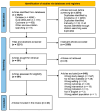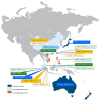The Cost-Effectiveness of the Human Papilloma Virus Vaccination in Asia Pacific Countries: What Lessons Can Indonesia Learn?-A Systematic Review
- PMID: 40573923
- PMCID: PMC12197709
- DOI: 10.3390/vaccines13060593
The Cost-Effectiveness of the Human Papilloma Virus Vaccination in Asia Pacific Countries: What Lessons Can Indonesia Learn?-A Systematic Review
Abstract
Background/Objectives: Cervical cancer is a significant issue in Indonesia, with many cases diagnosed at advanced stages. Although the human papillomavirus (HPV) vaccination has long been recommended by the WHO, it was only recently included in Indonesia's immunization program in 2023. This study aimed to examine the existing prevention strategies and their effectiveness through systematic review of the existing literature. Methods: We searched for cost-effectiveness studies of HPV vaccination in Asia Pacific countries from inception until 23 July 2023, using MEDLINE, Embase, and the Cochrane Library databases. The search strategy included keywords and subject terms for primary prevention, HPV vaccination, cervical cancer, and selected Asia Pacific Countries (Thailand, Vietnam, China, Singapore, Malaysia, Philippines, Korea, Japan, Taiwan, Australia, New Zealand, and Hong Kong). Studies selected were limited to original research articles with full text published in English in peer-reviewed journals, describing the cost-effectiveness of HPV vaccination in cervical cancer prevention in the Asia Pacific countries. Studies were excluded if there were no full text was available, if it was the wrong study design, non-English, or not based in the specific Asia Pacific countries selected. The titles and abstracts were screened, followed by full-text reviews using Covidence software, and analyzed using Excel. Results: Forty-three studies were included for review: 51% in high-income countries (HICs), 37% in upper-middle-income countries (UMICs), and 12% in low-middle-income countries (LMICs). All studies concluded that HPV vaccination is more cost-effective than screening alone. Nonavalent HPV vaccines were more cost-effective in HICs (80%), bivalent vaccines were more cost-effective in UMICs (66%), and gender-neutral vaccination was cost-effective compared to screening in all studies conducted. Conclusions: HPV vaccination is a cost-effective prevention strategy for cervical cancer across all resource settings, offering greater value compared to screening alone. Selecting the most economically viable vaccine type and expanding to gender-neutral vaccination could enhance early prevention efforts. These findings offer guidance for Indonesia in designing evidence-based HPV vaccination policies as a part of national cancer control efforts. Further investigation is necessary to determine the optimal strategy for HPV vaccination in Indonesia.
Keywords: Asia Pacific; Indonesia; cervical cancer; cost-effectiveness; human papillomavirus vaccination.
Conflict of interest statement
The authors declare no conflicts of interest.
Figures



Similar articles
-
Interventions targeted at women to encourage the uptake of cervical screening.Cochrane Database Syst Rev. 2021 Sep 6;9(9):CD002834. doi: 10.1002/14651858.CD002834.pub3. Cochrane Database Syst Rev. 2021. PMID: 34694000 Free PMC article.
-
A rapid and systematic review of the clinical effectiveness and cost-effectiveness of topotecan for ovarian cancer.Health Technol Assess. 2001;5(28):1-110. doi: 10.3310/hta5280. Health Technol Assess. 2001. PMID: 11701100
-
Immunogenicity and seroefficacy of pneumococcal conjugate vaccines: a systematic review and network meta-analysis.Health Technol Assess. 2024 Jul;28(34):1-109. doi: 10.3310/YWHA3079. Health Technol Assess. 2024. PMID: 39046101 Free PMC article.
-
Survivor, family and professional experiences of psychosocial interventions for sexual abuse and violence: a qualitative evidence synthesis.Cochrane Database Syst Rev. 2022 Oct 4;10(10):CD013648. doi: 10.1002/14651858.CD013648.pub2. Cochrane Database Syst Rev. 2022. PMID: 36194890 Free PMC article.
-
Prophylactic vaccination against human papillomaviruses to prevent cervical cancer and its precursors.Cochrane Database Syst Rev. 2018 May 9;5(5):CD009069. doi: 10.1002/14651858.CD009069.pub3. Cochrane Database Syst Rev. 2018. PMID: 29740819 Free PMC article.
References
-
- Singh D., Vignat J., Lorenzoni V., Eslahi M., Ginsburg O., Lauby-Secretan B., Arbyn M., Basu P., Bray F., Vaccarella S. Global estimates of incidence and mortality of cervical cancer in 2020: A baseline analysis of the WHO Global Cervical Cancer Elimination Initiative. Lancet Glob. Health. 2023;11:e197–e206. doi: 10.1016/S2214-109X(22)00501-0. - DOI - PMC - PubMed
-
- WHO . Regional Implementation Framework for Elimination of Cervical Cancer as a Public Health Problem: 2021–2030. World Health Organization. Regional Office for South-East Asia; New Delhi, India: 2021.
-
- United Nations Department of Economic and Social Affairs. Population Division World Population Prospects 2024. 2024. [(accessed on 23 May 2025)]. Available online: https://population.un.org/wpp/
-
- Bruni L.A.G., Serrano B., Mena M., Collado J.J., Gómez D., Muñoz J., Bosch F.X., de Sanjosé S. Human Papillomavirus and Related Diseases in Asia. 2023. [(accessed on 15 April 2024)]. Available online: https://hpvcentre.net/statistics/reports/XSX.pdf.
Publication types
LinkOut - more resources
Full Text Sources

